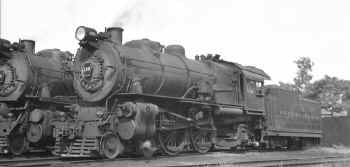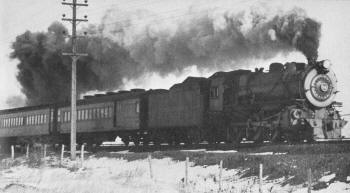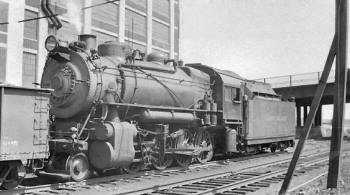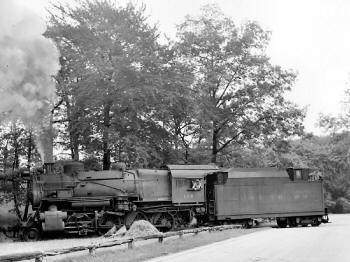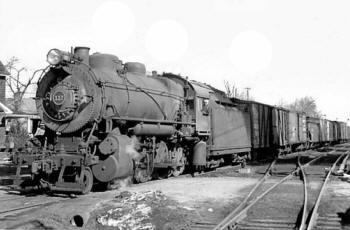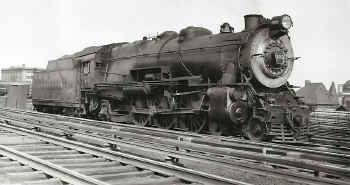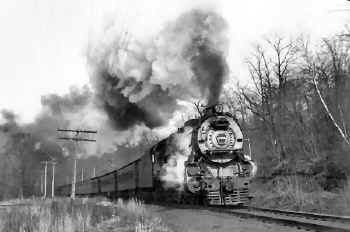LIRR STEAM SOUNDS
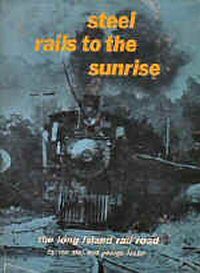
Steel Rails to the Sunrise – The Long Island Rail Road by Ron Ziel
and George H. Foster. 1965
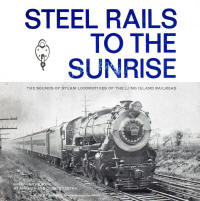
Steel Rails record jacket
Archive: Brad Phillips
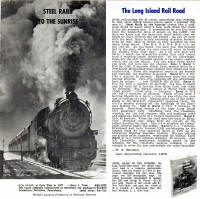
Steel Rails record jacket back cover
Archive: Brad Phillips
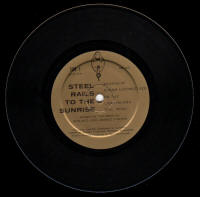
Published in 1965, a 45rpm record selling for $1.00 that could be ordered with Steel Rails to the Sunrise, of LIRR Steam Engines recorded while in service.
Archive: Brad Phillips
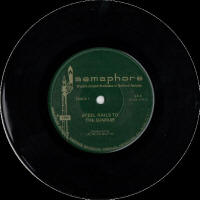
Archive: Bob Andersen
1. K-4 No. 5406 Floral Park, slowed down by a westbound Hempstead train crossed over ahead and now accelerating.
2. G-5 No. 5704 Eastbound main line local leaving Mineola. He's five minutes off the advertised; here he comes...and THERE HE GOES!
3. K-4 No. 3880 It's late at night and old train 647 is leaving New Hyde Park, last train 'til morning. The distant signal at Floral Park reads "high green". Next stop - Jamaica!
4. E-6 No. 460 Think of old train 5 leaving Speonk - late as was often the case due to loading the mail. Making good use of the downgrade to Eastport, reluctantly stopping there, the 4-4-2's whistle echoing off the buildings of the Eastport Milling Co.
W. S. Boerckel, Asst. Supervising Operator, LIRR
1. H-9 Switching sounds of the busy
Long Island City passenger yard. Shuffling over the crossings, wearing out
the bell clapper, side rod bushings loose and slapping; hallmark of a Pennsy
locomotive.
![]()
2. H-9 From the yard onto the main at Blissville. Working easy, down from
the cut-off, as the helper handles the load. The 2-8-0 whistles for
Greenpoint Ave. under the bridge.
![]()
3. L-1 Riverhead and more famous PRR rod-slapping as the largest class we
ever operated slows to pick up the brakeman flagging Roanoke Avenue. We are
getting our potato extra together, westbound for Holban Yard.
![]()
4. G-5 Just left Hicksville, westbound building speed as she whistles for
the Charlotte Avenue crossing - just enough to cover the law and satisfy the
rules examiner.
![]()
W. S. Boerckel, Asst. Supervising Operator, LIRR
PRR leased to LIRR 2-8-2 Class L1s Numbers: 714, 1286, 1385, 1478, 1542, 1625, 3078, 3408, 3518, 3580, 3590 Research: Dave Keller L1s at Riverhead:
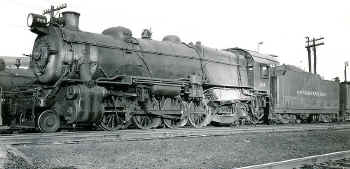
Pennsylvania Railroad L1s #804 Juniata Shops, PA 1917
Archive: Edward J. Ozog
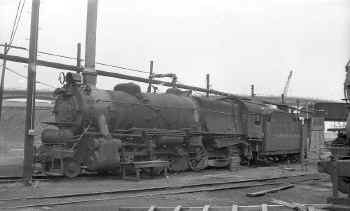
PRR L1s #8283 as a stationary boiler at Wheelspur Yard, LI City c.1956
Archive: Dave Keller
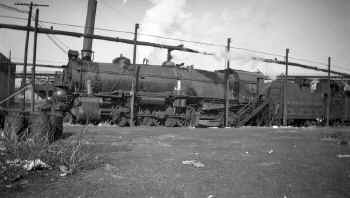
PRR L1s #8148 as a stationary boiler at Wheelspur Yard, LI City 2/22/1956 Archive: Dave Keller
The 2-8-2 wheel arrangement allowed the locomotive's firebox to be placed behind instead of above the driving wheels, thereby allowing a larger firebox that could be both wide and deep. This supported a greater rate of combustion and thus a greater capacity for steam generation, allowing for more power at higher speeds. Allied with the larger driving wheel diameter which was possible when they did not impinge on the firebox, it meant that the 2-8-2 was capable of higher speeds than a 2-8-0 with a heavy train. These locomotives did not suffer from the imbalance of reciprocating parts as much as did the 2-6-2 or the 2-10-2, because the center of gravity was between the second and third drivers instead of above the center driver. At times it was also referred to on some railroads in the United States of America as the McAdoo Mikado and, during the Second World War, the MacArthur. After the war, the type name "Mikado" again became the most common for this locomotive type. Source: Wikipedia
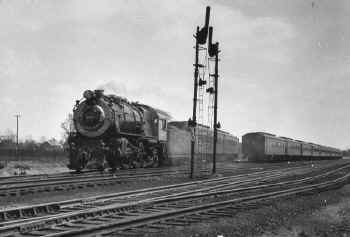
E6s #460 westbound at KO Signals Ronkonkoma 3/1938
Archive: Dave Keller
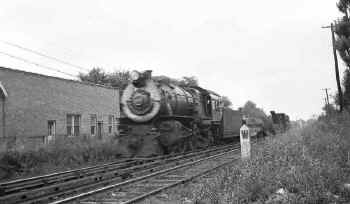
E6s #460 Wreck train - Old Southern Rd., Laurelton 10/20/1939 Archive: Dave Keller
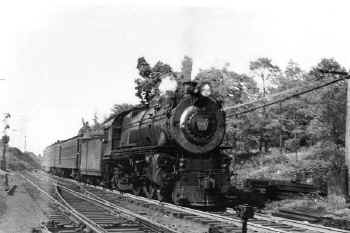
E6s #1287 running against traffic Roslyn 1940 (T. Sommer-Keller)
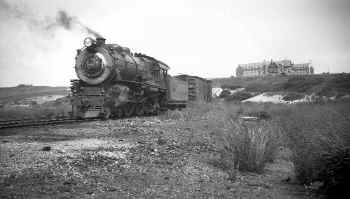
E6s #1600 freight at Montauk View E 1939 Archive: Dave Keller
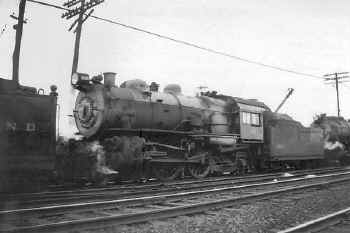
E6s #737- Patchogue Loco Terminal View NE c.1946
Archive: Dave Keller
The class E6s replaced the earlier E3sd Atlantic types. Among other things the E3sd locomotives were recognizable by their taller smokestacks. Research: Dave Keller
In the 1920s the Pennsylvania Railroad needed a locomotive for commuter trains. When the first G5s rolled out of the Juniata shops in 1923, the Pennsylvania Railroad hadn't built a 4-6-0 in more than two decades. Mechanical Engineer William F. Kiesel, Jr. who designed the engine used the boiler from an E6s Atlantic and designed one of the largest and most powerful ten-wheelers ever built. Smaller drive wheels than an Atlantic and the lack of a trailing truck put more weight on the drivers and produced an engine with great power and acceleration but a lower top speed. The 4-6-0 wheel arrangement could provide sufficient tractive effort, (41,000 lbs of tractive force) but at the same time, allow the locomotive to accelerate the train more quickly. Such a design was ideal for the frequent stops on PRR commuter lines.
The G5s (#20 thru #50, inclusive )was the primary passenger locomotive on the Long Island Railroad until the end of steam operations, sharing the duty with K4s's and other G5's leased from the PRR, as well as diesels such as the Alco RS3 that ultimately replaced them. The G5s locomotives on Long Island differed slightly from those produced for the PRR, with a larger tender typically used by the K4s.[2]
The G5s was the last steam locomotive to operate in revenue service on Long Island. The last seven in operation, numbers 21, 24, 32, 35, 38, 39, and 50, were in service until late 1955. In October of that year, a special "End of Steam Ceremony" was held at Hicksville. Engines 35 and 39 each pulled a single coach to the station with local Boy Scouts on board. Upon arriving, the coaches were uncoupled from the two steam engines, and each coupled to an Alco RS3 diesel locomotive. 35 and 39 were then coupled nose to nose, and ran west to the shops at Morris Park. 35 would run one more fantrip the following
week. Source: Wikipedia
G5s #22 Morris Park Shops 2/04/38 Archive: Dave Keller
G5s #22 is seen here laying up at Morris Park Shops on February 4, 1938. In the foreground can be seen the remaining wooden safety guard for a section of electrified third rail which apparently had been removed at the time of this image. Looking northwest, this photo appears to have been taken about where the "new" concrete coaling tower would be constructed 6 years later. Research: Dave Keller
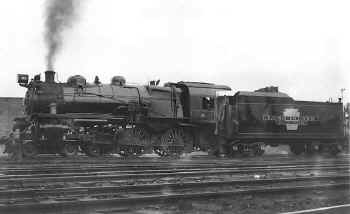
G5s #21 - Sunrise Special tender Archive: Art Huneke

G5s #39 at Oyster Bay Photo/Archive: Art Huneke
G5s #39 westbound
from Hicksville whistle for the
Charlotte Avenue crossing:
![]()
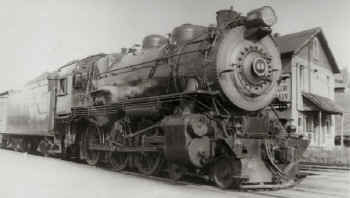
G5s #49 c. 1940 at Port Jefferson. The building behind the loco is the REMZ Purina Feeds Bldg. fronting Rte. 112 across from the station platform.
H9s Class: The Pennsylvania Railroad's class H8, H9s and H10s steam locomotives were of the 2-8-0 "Consolidation" type, the last three classes of such built by the railroad. The three classes differed only in cylinder diameter and thus tractive effort, each subsequent class increasing that measurement by an inch. The first H8 was built in 1907 and the last H10 in 1916; within a few years they were replaced on heavy freight assignments by 2-8-2s and 2-10-0. They became the railroad's standard light freight locomotive, replacing all other class H 2-8-0s. A number of H8 locomotives were rebuilt to H9s specification and were leased to the PRR-owned Long Island Rail Road, becoming the primary freight-hauling type on this system and remained in service on the LIRR until 1949. Source: Wikipedia
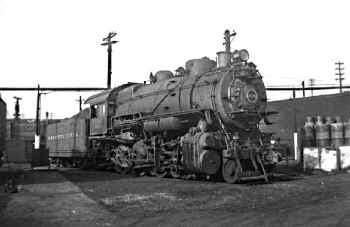
H9s #2826 on garden tracks - Morris Park Shops Jamaica
View NE 10/31/1948 (N. Rolf-Keller)
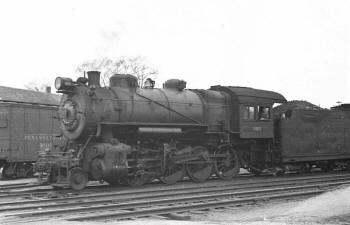
PRR leased H9s #580 with well-stocked tender
is westbound on a yard track opposite the station platform and is about to
cross Osborne Avenue at Riverhead, NY in this view from June, 1933. The
fireman is watching the photographer.
(Dave Keller archive)
_small.jpg)
PRR-leased H9s #910 is running light eastbound at MP6 in Glendale, NY. on a cold, snowy January 31, 1948. The steam from the stack is tight and crisp in the cold air. This view is looking west with Woodhaven Blvd. behind the photographer. (Ed Hermanns photo, Dave Keller archive)
